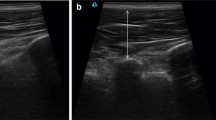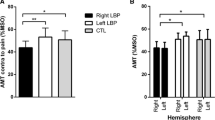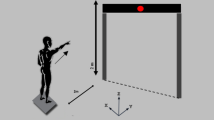Abstract
Contralateral transversus abdominis muscle (cTrA) is known to be anticipatory to rapid focal movement. The activation of ipsilateral TrA (iTrA) follows cTrA, but their anticipatory interaction in healthy subjects seems to be delayed in low back pain (LBP) patients. TrA delay in LBP is linked with reorganization of the primary motor cortex (M1), thus supporting that cortical changes underlie the altered postural control. Our study tested whether differences in postural adjustments were present in LBP for TrA onsets and co-activation, and whether these differences were paralleled by cortical motor changes. Thirteen chronic LBP patients and 9 healthy Controls were enrolled. Surface recordings of cTrA/internal oblique (IO) and iTrA/IO were collected during a rapid shoulder flexion task while standing. Transcranial magnetic stimulation of M1 tested TrA/IO corticospinal excitability, active motor threshold and short-interval intracortical inhibition (SICI). In LBP compared to Controls, iTrA/IO activation was delayed, co-activation was absent, timing between TrA/IO onsets was impaired, and SICI was missing. Between-outcomes correlations observed in one group were not significant in the other. Delay of iTrA/IO and the lacking co-activation were not explained by between-group differences of transcranial magnetic stimulation outcomes. TrA/IO co-activation is present during rapid focal movement in healthy subjects only. LBP patients displayed an important alteration of the control of spine stability that can be explained by altered mechanisms of M1 motor programming.





Similar content being viewed by others
Abbreviations
- M1:
-
Primary motor cortex
- MEP:
-
Motor evoked potential
- SICI:
-
Short intracortical inhibition
- TMS:
-
Transcranial magnetic stimulation
- TrA:
-
Transversus abdominis
References
Allison GT, Morris SL (2008) Transversus abdominis and core stability: has the pendulum swung? Br J Sports Med 42:930–931
Allison GT, Morris SL, Lay B (2008) Feedforward responses of transversus abdominis are directionally specific and act asymmetrically: implications for core stability theories. J Orthop Sports Phys Ther 38:228–237
Aruin AS, Latash ML (1995) Directional specificity of postural muscles in feed-forward postural reactions during fast voluntary arm movements. Exp Brain Res 103:323–332
Barker PJ, Briggs CA, Bogeski G (2004) Tensile transmission across the lumbar fasciae in unembalmed cadavers: effects of tension to various muscular attachments. Spine (Phila Pa 1976) 29:129–138
Barker PJ, Guggenheimer KT, Grkovic I, Briggs CA, Jones DC, Thomas CD, Hodges PW (2006) Effects of tensioning the lumbar fasciae on segmental stiffness during flexion and extension: young investigator award winner. Spine (Phila Pa 1976) 31:397–405
Belen’kii VEGV, Palt’sev EI (1967) Control elements of voluntary movements. Biofizika 12:135–141
Boroojerdi B, Battaglia F, Muellbacher W, Cohen LG (2001) Mechanisms influencing stimulus-response properties of the human corticospinal system. Clin Neurophysiol 112:931–937
Cresswell AG, Grundstrom H, Thorstensson A (1992) Observations on intra-abdominal pressure and patterns of abdominal intra-muscular activity in man. Acta Physiol Scand 144:409–418
Di Lazzaro V, Restuccia D, Oliviero A et al (1998) Magnetic transcranial stimulation at intensities below active motor threshold activates intracortical inhibitory circuits. Exp Brain Res 119:265–268
Eisenberg E, Chistyakov AV, Yudashkin M, Kaplan B, Hafner H, Feinsod M (2005) Evidence for cortical hyperexcitability of the affected limb representation area in CRPS: a psychophysical and transcranial magnetic stimulation study. Pain 113:99–105
Ferbert A, Caramia D, Priori A, Bertolasi L, Rothwell JC (1992) Cortical projection to erector spinae muscles in man as assessed by focal transcranial magnetic stimulation. Electroencephalogr Clin Neurophysiol Evoked Potentials Sect 85:382–387
Flor H, Braun C, Elbert T, Birbaumer N (1997) Extensive reorganization of primary somatosensory cortex in chronic back pain patients. Neurosci Lett 224:5–8
Gagne M, Schneider C (2008) Dynamic influence of wrist flexion and extension on the intracortical inhibition of the first dorsal interosseus muscle during precision grip. Brain Res 1195:77–88
Gagné M, Schneider C (2008) Dynamic influence of wrist flexion and extension on the intracortical inhibition of the first dorsal interosseus muscle during precision grip. Brain Res 1195:77–88
Grenier SG, McGill SM (2007) Quantification of lumbar stability by using 2 different abdominal activation strategies. Arch Phys Med Rehabil 88:54–62
Hodges P (2008) Transversus abdominis: a different view of the elephant. Br J Sports Med 42:941–944
Hodges PW, Bui BH (1996) A comparison of computer-based methods for the determination of onset of muscle contraction using electromyography. Electroencephalogr Clin Neurophysiol 101:511–519
Hodges PW, Richardson CA (1996) Inefficient muscular stabilization of the lumbar spine associated with low back pain. A motor control evaluation of transversus abdominis. Spine (Phila Pa 1976) 21:2640–2650
Hodges PW, Richardson CA (1997a) Contraction of the abdominal muscles associated with movement of the lower limb. Phys Ther 77:132–142
Hodges PW, Richardson CA (1997b) Feedforward contraction of transversus abdominis is not influenced by the direction of arm movement. Exp Brain Res 114:362–370
Hodges PW, Richardson CA (1998) Delayed postural contraction of transversus abdominis in low back pain associated with movement of the lower limb. J Spinal Disord 11:46–56
Hodges PW, Richardson CA (1999) Altered trunk muscle recruitment in people with low back pain with upper limb movement at different speeds. Arch Phys Med Rehabil 80:1005–1012
Hodges PW, Cresswell AG, Daggfeldt K, Thorstensson A (2001) In vivo measurement of the effect of intra-abdominal pressure on the human spine. J Biomech 34:347–353
Jacobs JV, Henry SM, Nagle KJ (2010) Low back pain associates with altered activity of the cerebral cortex prior to arm movements that require postural adjustment. Clin Neurophysiol 121:431–440
Kloppel S, Baumer T, Kroeger J, Koch MA, Buchel C, Munchau A, Siebner HR (2008) The cortical motor threshold reflects microstructural properties of cerebral white matter. Neuroimage 40:1782–1791
Kujirai T, Caramia MD, Rothwell JC et al (1993) Corticocortical inhibition in human motor cortex. J Physiol 471:501–519
Lefaucheur JP, Drouot X, Menard-Lefaucheur I, Keravel Y, Nguyen JP (2006) Motor cortex rTMS restores defective intracortical inhibition in chronic neuropathic pain. Neurology 67:1568–1574
Marshall P, Murphy B (2003) The validity and reliability of surface EMG to assess the neuromuscular response of the abdominal muscles to rapid limb movement. J Electromyogr Kinesiol 13:477–489
Marshall P, Murphy B (2006) The effect of sacroiliac joint manipulation feed-forward activation times of the deep abdominal musculature. J Manipulative Physiol Ther 29:196–202
Masse-Alarie H, Schneider C (2011) Cerebral reorganization in chronic low back pain and neurostimulation to improve motor control. Neurophysiol Clin 41:51–60
Mhalla A, de Andrade DC, Baudic S, Perrot S, Bouhassira D (2010) Alteration of cortical excitability in patients with fibromyalgia. Pain 149:495–500
Morris SL, Lay B, Allison GT (2011) Corset hypothesis rebutted—transversus abdominis does not co-contract in unison prior to rapid arm movements. Clin Biomech (Bristol, Avon). doi:S0268-0033(11)00246-4 [pii]
Moseley GL (2008) I can’t find it! Distorted body image and tactile dysfunction in patients with chronic back pain. Pain 140:239–243
Moseley GL, Hodges PW (2005) Are the changes in postural control associated with low back pain caused by pain interference? Clin J Pain 21:323–329
Ng JK, Kippers V, Parnianpour M, Richardson CA (2002) EMG activity normalization for trunk muscles in subjects with and without back pain. Med Sci Sports Exerc 34:1082–1086
Orth M, Rothwell JC (2004) The cortical silent period: intrinsic variability and relation to the waveform of the transcranial magnetic stimulation pulse. Clin Neurophysiol 115:1076–1082
Ortu E, Deriu F, Suppa A, Tolu E, Rothwell JC (2008) Effects of volitional contraction on intracortical inhibition and facilitation in the human motor cortex. J Physiol 586:5147–5159
Reis J, Swayne OB, Vandermeeren Y et al (2008) Contribution of transcranial magnetic stimulation to the understanding of cortical mechanisms involved in motor control. J Physiol 586:325–335
Richardson CA, Snijders CJ, Hides JA, Damen L, Pas MS, Storm J (2002) The relation between the transversus abdominis muscles, sacroiliac joint mechanics, and low back pain. Spine (Phila Pa 1976) 27:399–405
Richardson CA, Hides JA, Wilson S, Stanton W, Snijders CJ (2004) Lumbo-pelvic joint protection against antigravity forces: motor control and segmental stiffness assessed with magnetic resonance imaging. J Gravit Physiol 11:P119–P122
Ridding MC, Rothwell JC (1999) Afferent input and cortical organisation: a study with magnetic stimulation. Exp Brain Res 126:536–544
Ridding MC, Taylor JL, Rothwell JC (1995a) The effect of voluntary contraction on cortico-cortical inhibition in human motor cortex. J Physiol 487(Pt 2):541–548
Ridding MC, Taylor JL, Rothwell JC (1995b) The effect of voluntary contraction on cortico-cortical inhibition in human motor cortex. J Physiol 487:541–548
Rossi S, Hallett M, Rossini PM, Pascual-Leone A (2009) Safety, ethical considerations, and application guidelines for the use of transcranial magnetic stimulation in clinical practice and research. Clin Neurophysiol 120:2008–2039
Salerno A, Thomas E, Olive P, Blotman F, Picot MC, Georgesco M (2000) Motor cortical dysfunction disclosed by single and double magnetic stimulation in patients with fibromyalgia. Clin Neurophysiol 111:994–1001
Schwenkreis P, Witscher K, Janssen F, Dertwinkel R, Zenz M, Malin J-P, Tegenthoff M (2000) Changes of cortical excitability in patients with upper limb amputation. Neurosci Lett 293:143–146
Schwenkreis P, Janssen F, Rommel O et al (2003) Bilateral motor cortex disinhibition in complex regional pain syndrome (CRPS) type I of the hand. Neurology 61:515–519
Schwenkreis P, Scherens A, Ronnau A-K, Hoffken O, Tegenthoff M, Maier C (2010) Cortical disinhibition occurs in chronic neuropathic, but not in chronic nociceptive pain. BMC Neurosci 11:73
Silfies SP, Mehta R, Smith SS, Karduna AR (2009) Differences in feedforward trunk muscle activity in subgroups of patients with mechanical low back pain. Arch Phys Med Rehabil 90:1159–1169
Strutton PH, Catley M, McGregor AH, Davey NJ (2003) Corticospinal excitability in patients with unilateral sciatica. Neurosci Lett 353:33–36
Strutton PH, Beith ID, Theodorou S, Catley M, McGregor AH, Davey NJ (2004) Corticospinal activation of internal oblique muscles has a strong ipsilateral component and can be lateralised in man. In: Experimental brain research, vol 158. Springer, Berlin, pp 474–479
Strutton PH, Theodorou S, Catley M, McGregor AH, Davey NJ (2005) Corticospinal excitability in patients with chronic low back pain. J Spinal Disord Tech 18:420–424
Tesh KM, Dunn JS, Evans JH (1987) The abdominal muscles and vertebral stability. Spine (Phila Pa 1976) 12:501–508
Tsao H, Galea MP, Hodges PW (2008a) Concurrent excitation of the opposite motor cortex during transcranial magnetic stimulation to activate the abdominal muscles. J Neurosci Methods 171:132–139
Tsao H, Galea MP, Hodges PW (2008b) Reorganization of the motor cortex is associated with postural control deficits in recurrent low back pain. Brain 131:2161–2171
Tsao H, Galea MP, Hodges PW (2010) Driving plasticity in the motor cortex in recurrent low back pain. Eur J Pain 14:832–839
Urquhart DM, Barker PJ, Hodges PW, Story IH, Briggs CA (2005) Regional morphology of the transversus abdominis and obliquus internus and externus abdominis muscles. Clin Biomech (Bristol, Avon) 20:233–241
Ziemann U, Lonnecker S, Steinhoff BJ, Paulus W (1996) Effects of antiepileptic drugs on motor cortex excitability in humans: a transcranial magnetic stimulation study. Ann Neurol 40:367–378
Acknowledgments
The authors acknowledge the support of the Canadian Foundation for Innovation (CS equipment), the Fonds de Recherche en Santé du Québec (HMA MSc studentship, VHF PhD studentship) and the Hôtel-Dieu de Lévis’s hospital for patients’ recruitment facilities.
Conflict of interest
Authors declare that they do not have any financial relationship relevant to this article to disclose and no conflict of interest.
Author information
Authors and Affiliations
Corresponding author
Rights and permissions
About this article
Cite this article
Massé-Alarie, H., Flamand, V.H., Moffet, H. et al. Corticomotor control of deep abdominal muscles in chronic low back pain and anticipatory postural adjustments. Exp Brain Res 218, 99–109 (2012). https://doi.org/10.1007/s00221-012-3008-9
Received:
Accepted:
Published:
Issue Date:
DOI: https://doi.org/10.1007/s00221-012-3008-9




